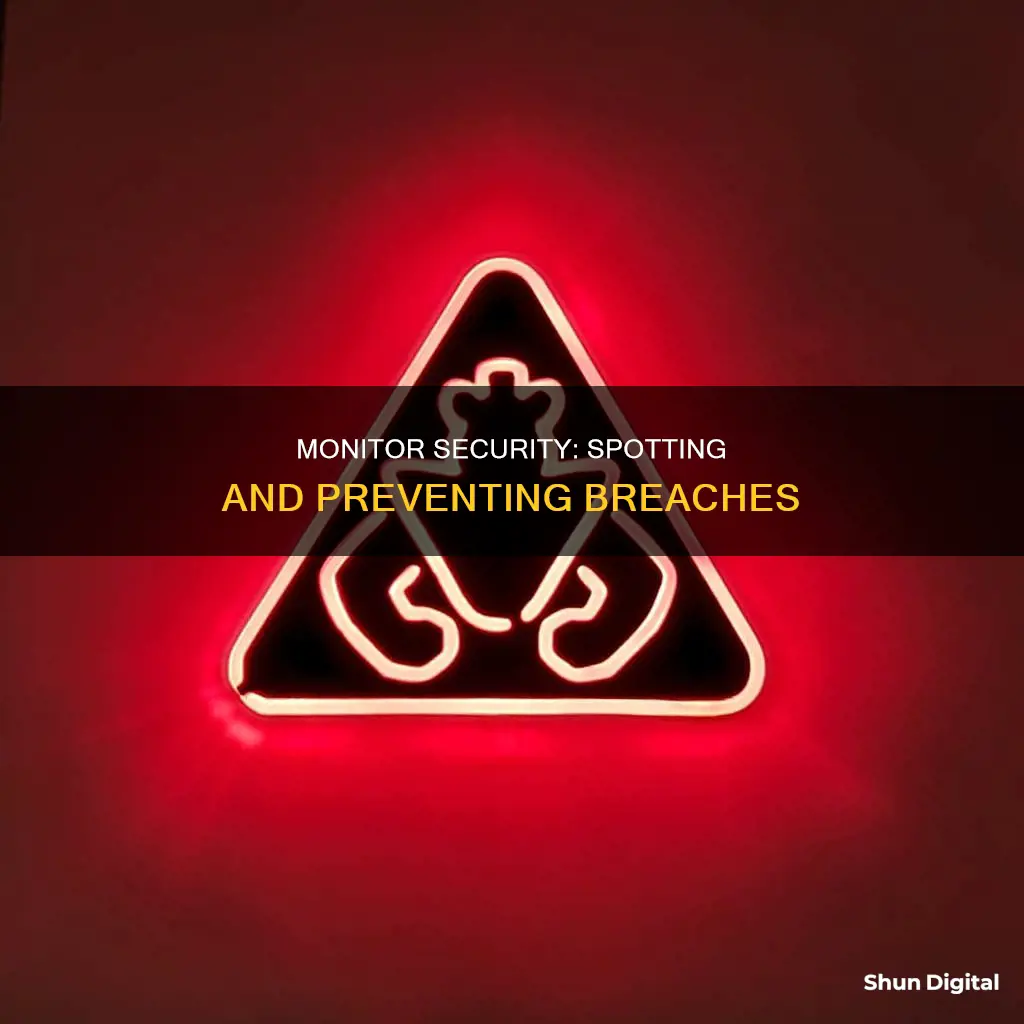
Data breaches are an unfortunate reality of the modern workplace and can lead to significant financial losses and a loss of consumer trust. Detecting a breach quickly is essential for mitigating damage and preventing cybercrime.
There are several tools and strategies that can be employed to spot security breaches, such as data breach detection tools, global threat intelligence, and continuous monitoring of the dark web, private hacker forums, and criminal marketplaces. Additionally, providing regular staff awareness training and staying up-to-date with new attack methods can also help to identify and prevent breaches.
It is important to note that there is no one-size-fits-all solution, and a combination of measures is often necessary to effectively monitor and respond to security breaches.
| Characteristics | Values |
|---|---|
| Data breach monitoring tools | Have I Been Pwned, HackNotice, Identity Leak Checker, 1Password, Firefox Monitor, Google Password Checkup, Okta's Passprotect |
| Modern, cloud-based tools | Cloud-based systems, PSIM software platforms |
| Global threat intelligence | The SANS State of Cyber Threat Intelligence Survey |
| Breach detection platform provider | Lastline |
What You'll Learn

Monitor dark web sources, hacker forums, and criminal marketplaces
The dark web is a non-public facing corner of the internet that isn't visible to search engines and requires special browsing capabilities to access. It is a place where individuals can operate under the guise of anonymity, making it a hub for illicit cybercrime activities such as drug trafficking, data leaks, and illegal marketplaces. It is important to monitor dark web sources, hacker forums, and criminal marketplaces to better protect your business from those using the dark web to conduct criminal activity.
Security analysts can gather open-source intelligence (OSINT) on the dark web to better understand potential threats. Dark web monitoring can be beneficial to many companies for research and threat intelligence purposes. It can help them combat illicit and criminal activities and help prevent data breaches and other malicious attacks.
- Crypt BB: An encrypted open-source forum for the hacker elites. This forum utilizes military-grade symmetric cipher AES 256 CTR for encrypting messages and asymmetric ciphers for password exchange.
- Dread: A dark web forum designed to mimic the look of Reddit. It provides community discussion boards and sub-communities, with the main goal of offering a censorship-free forum.
- Nulled: A large dark web forum with millions of views. It gained infamy due to a 2016 hack that led to a massive data breach on platforms such as PayPal.
- FreeHacks: One of the largest and most popular hacking forums, this Russian-based community of hackers and cybercriminals shares resources to expand their knowledge base.
- Exploit: One of the longest-running forums on the dark web, active since at least 2005. It caters to Russian-speaking actors but also accepts English speakers. Discussions about ransomware are banned, but ransomware-as-a-service operators are still active on the forum.
- XSS: A highly notable Russian hacker forum that shares information about exploits, vulnerabilities, carding, illicit access marketplaces, and credential databases.
By monitoring these and other dark web sources, organizations can stay ahead of emerging threats and protect themselves and their customers.
Is Your Monitor TN? Check with These Simple Steps
You may want to see also

Use data breach detection tools
Data breach detection tools are an essential part of an organisation's cyber defences. They work by monitoring your network, devices, and the dark web for suspicious activity or signs of a breach. They continuously scan, search, and analyse internal network traffic and the dark web to identify the illegal trading or sharing of sensitive information, such as credentials, financial information, or intellectual property.
There are several tools available that can help detect data breaches. Here are some of the best tools and practices to help you get started:
Have I Been Pwned
A widely-used online service that allows individuals to check if their personal data was compromised in a third-party data breach. It offers a searchable database of exposed credentials and provides notifications for new breaches. This service is geared towards individuals concerned about online privacy and security.
Breachsense
A dark web monitoring tool that provides real-time visibility into stolen credentials and sensitive data exposed on the dark web. The platform combines automated OSINT collection with human intelligence (HumInt) to return actionable intelligence that organisations can use to mitigate risks associated with data breaches and account takeovers.
1Password
A password manager that helps ensure all your passwords are strong and unique. It also has a feature called WatchTower, which warns you when you're using a password that is known to be breached or when you're still using a breached password on a compromised website.
Firefox Monitor
A service that uses Have I Been Pwned under the hood. It shows alerts only when you visit a recently breached site.
Google Password Checkup
A chrome extension that uses Google's database of 4 billion leaked credentials to check if the combination of the username and password provided by the user has been found in the set of leaked data.
Okta's Passprotect
A plugin that uses Troy Hunt's Pwned Passwords, a set of 550 million breached passwords, and alerts you via a pop-up when you enter a breached password in a login form.
SolarWinds Security Event Manager
An entry-level Security Information and Event Management (SIEM) tool with excellent log management and correlation features as well as an impressive reporting engine. The tool also boasts excellent event response features that leave nothing to be desired, including a detailed real-time response system that will actively react to every threat.
ManageEngine Log360
A SIEM solution with DLP and CASB capability integrations, offering a full-spectrum, end-to-end service. It deploys an intelligent mix of multiple cutting-edge features relating to threat intelligence, anomaly detection, and rule-based attack detection to detect, prioritise, investigate, and respond to sophisticated attacks.
Splunk Enterprise Security
A popular SIEM tool that is particularly well-known for its analytics capabilities. It monitors your system's data in real time, looking for vulnerabilities and signs of abnormal and/or malicious activity. It also has a simple and uncluttered user interface.
SpyCloud
A unique tool from an Austin-based security company that offers accurate, operationalised data that organisations can use to protect their users and their company from data breaches. This includes normalising, de-duplicating, validating, and enriching all the data it collects.
Kount
A Software-as-a-Service (SaaS) data breach detection platform that provides data security and breach detection services to organisations worldwide. Its patented machine learning technology examines transactions at a microscopic level to detect and stop malicious activities.
ReliaQuest SearchLight
A platform that offers dark web monitoring and digital risk protection services, providing visibility into a wide range of digital risks, including exposed data, brand impersonation, and cyber threats. ReliaQuest combines data analytics with human intelligence to deliver actionable insights for organisations.
Recorded Future
A threat intelligence platform that provides real-time monitoring of the dark web and other sources of intelligence. The platform uses machine learning and natural language processing to analyse and correlate data, helping organisations identify and respond to potential threats.
IntSights
A cyber threat intelligence and mitigation platform that provides dark web monitoring and digital risk protection. The platform delivers threat intelligence and automated remediation capabilities to help organisations defend against cyber threats.
ZeroFox
A digital risk protection platform that offers dark web monitoring as part of its suite of services, providing visibility into cyber threats, data leaks, and brand impersonation across the dark web and other digital channels.
Flashpoint
A platform that specialises in business risk intelligence, offering dark web monitoring and analysis to help organisations identify and mitigate threats. Flashpoint provides access to a broad range of illicit communities and marketplaces, delivering insights into cybercriminal activities and trends.
CyberInt
A digital risk protection platform that includes dark web monitoring services, helping organisations detect and respond to cyber threats, data breaches, and online fraud. CyberInt's continuous monitoring and intelligence-driven approach provide actionable insights for effective risk management.
Best Practices
In addition to using data breach detection tools, here are some best practices to help prevent and mitigate data breaches:
- Use strong and unique passwords: This helps ensure that a breach of one service doesn't put your other services at risk.
- Enable two-factor authentication: This adds an extra layer of security to your accounts.
- Regularly update and patch software: This helps prevent vulnerabilities that attackers can exploit.
- Encrypt sensitive data: This makes it more difficult for unauthorised individuals to access and leak information.
- Monitor for data breaches: Use data breach notification tools and services to stay informed about any potential breaches.
Worth Investing in a 240Hz Monitor?
You may want to see also

Bring in cybersecurity experts
When it comes to spotting and monitoring security breaches, it is crucial to bring in cybersecurity experts who can provide valuable insights and guidance. Here are some key reasons why enlisting the help of cybersecurity professionals is essential:
Expertise and Experience:
Cybersecurity experts bring a wealth of knowledge and experience in identifying and mitigating security threats. They are adept at recognising complex patterns, analysing vulnerabilities, and implementing effective security measures. Their expertise covers a broad range of potential threats, including malware, phishing, social engineering, and zero-day exploits. By leveraging their expertise, organisations can enhance their ability to spot and respond to security breaches promptly and effectively.
Proactive Threat Detection:
Cybersecurity experts employ advanced tools and technologies to proactively detect potential threats. They can set up monitoring systems, analyse network traffic, and identify suspicious activities that may indicate an impending or ongoing security breach. By proactively hunting for threats, they can help prevent breaches before they occur or minimise their impact if they do.
Incident Response and Forensic Analysis:
In the event of a security breach, cybersecurity experts play a crucial role in incident response. They can help contain the breach, perform forensic analysis to identify the source and scope of the incident, and develop remediation plans. Their expertise in digital forensics enables them to collect and analyse evidence, track the activities of intruders, and provide insights that can aid in legal proceedings or insurance claims.
Strategic Security Planning:
Cybersecurity experts are instrumental in developing and implementing comprehensive security strategies. They can assess an organisation's current security posture, identify gaps or weaknesses, and recommend improvements. This includes establishing security policies and procedures, implementing security controls, and conducting security awareness training for employees. By involving cybersecurity experts in strategic planning, organisations can strengthen their overall security posture and reduce the likelihood of future breaches.
Compliance and Regulatory Guidance:
Cybersecurity experts help organisations navigate the complex landscape of compliance and regulatory requirements related to data security. They stay abreast of industry standards, privacy laws, and data breach notification mandates. By providing guidance on compliance, they ensure that organisations adhere to legal obligations, mitigate regulatory risks, and maintain the trust of their customers and stakeholders.
In conclusion, bringing in cybersecurity experts is a critical aspect of effectively spotting and monitoring security breaches. Their specialised skills, combined with advanced tools and technologies, enable organisations to strengthen their defences, respond to incidents swiftly, and maintain the integrity and security of their systems and data.
Host Monitoring Nozzle: Missing from SCM, Now What?
You may want to see also

Monitor attack campaigns
Monitoring attack campaigns is a crucial aspect of cybersecurity. Here are some detailed strategies to effectively monitor attack campaigns:
- Utilize Modern Breach Detection Tools: It is essential to employ modern breach detection tools alongside maintaining systems, servers, and applications. Many organizations make the mistake of investing in outdated technology that is no longer effective against evolving cyber threats. By leveraging cutting-edge tools, you can stay ahead of attackers and protect your data.
- Focus on Attack Campaigns, Not Just Individual Alerts: Conventional malware detection products often generate notifications for point-in-time threats, resulting in an overwhelming number of irrelevant alerts for security analysts to sift through. Instead, shift your focus to monitoring attack campaigns. This approach enables you to identify patterns and spot breaches early on, allowing for a more proactive security posture.
- Leverage Global Threat Intelligence: According to The SANS State of Cyber Threat Intelligence Survey, organizations that utilize global cyber threat intelligence are better equipped to respond to new threats. They achieve faster and more accurate response times, enhancing their ability to identify, detect, and prevent potential attacks.
- Monitor Key Indicators of Compromise: Security analysts need visibility into the network-level telemetry, logs, and events from the underlying infrastructure, applications, and security systems. This comprehensive view enables them to effectively detect and investigate security incidents, identifying potential attack campaigns before they inflict significant damage.
- Implement Continuous Monitoring: Continuous monitoring of sources like the dark web, hacker forums, and ransomware channels is essential for early breach detection. By tracking leaked credentials, stolen company data, and unusual activity patterns, your security team can stay ahead of attackers and mitigate potential threats.
By adopting these strategies, you can strengthen your organization's cybersecurity posture and minimize the impact of potential attack campaigns.
Monitoring Data Usage: A Guide for Linksys Routers
You may want to see also

Provide regular staff awareness training
Providing regular staff awareness training is essential to ensuring employees understand the importance of cybersecurity and data privacy. Here are some detailed tips on how to provide effective training:
Develop a Comprehensive Cybersecurity Policy:
Create a company-wide cybersecurity policy that covers the rules and protocols employees should follow. This policy should be formally documented and shared with all employees, with periodic discussions and tests to ensure ongoing adherence. The policy should be understandable, relatable, and diversified. Use simple language, relate it to personal device safety, and vary your communication methods to ensure engagement.
Make Following Protocols a Priority:
Ensure employees know the proper steps to take in the event of a security breach. This includes reporting suspicious activity, regularly changing passwords, and keeping software up to date. Emphasize the importance of following protocols to mitigate the impact of a potential breach.
Provide Regular Cyber Training and Updates:
Offer cyber security training during the onboarding process and provide regular updates to all employees. Cover potential threats such as phishing scams, social engineering tactics, and malware protection. Ensure employees know how to recognize and respond to these threats.
Take Advantage of Online Cybersecurity Courses:
Utilize free or low-cost online resources to enhance employee training. For example, the FTC (Federal Trade Commission) website offers educational resources and quizzes. The National Institute of Standards and Technology also provides free and low-cost online training content specifically designed for employees.
Teach Employees to Spot Suspicious Activity:
Train employees to identify signs of suspicious activity, such as new apps or programs appearing on their devices, strange pop-ups, slow device performance, or new browser extensions or tabs. Encourage them to report any suspicious activity immediately.
Reinforce Confidentiality:
Emphasize the importance of password security and authentication, even when working remotely. Teach employees about the risks of using universal passwords and provide examples of past data breaches. Discuss the benefits of VPNs, multi-factor authentication, and other secure log-on processes.
By implementing these strategies, organizations can empower their employees to be vigilant and proactive in protecting against security threats. Regular and comprehensive staff awareness training is a critical component of any organization's cybersecurity strategy.
Removing Rubber Covers from Your ASUS Monitor Easily
You may want to see also
Frequently asked questions
You can use data breach monitoring tools such as "Have I Been Pwned", which is a data breach notification service. You can also use Google Password Checkup, which is a Chrome extension that uses Google's database of leaked credentials to check if your password has been compromised.
Common causes of data breaches include weak and stolen credentials, backdoors, social engineering, malware, and unpatched applications.
If you detect a security breach, you should change your passwords immediately, check for fraudulent bank transactions, and sign up for a credit monitoring service. You should also notify your organization's security team so that they can respond and prevent further damage.
To protect yourself from security breaches, use strong and unique passwords for each of your accounts. You can use a password manager to help you generate and remember secure passwords. Additionally, enable two-factor authentication (2FA) for an extra layer of security.







